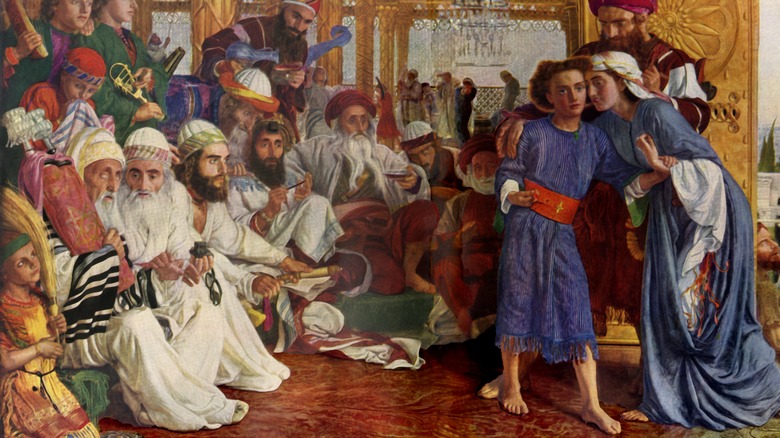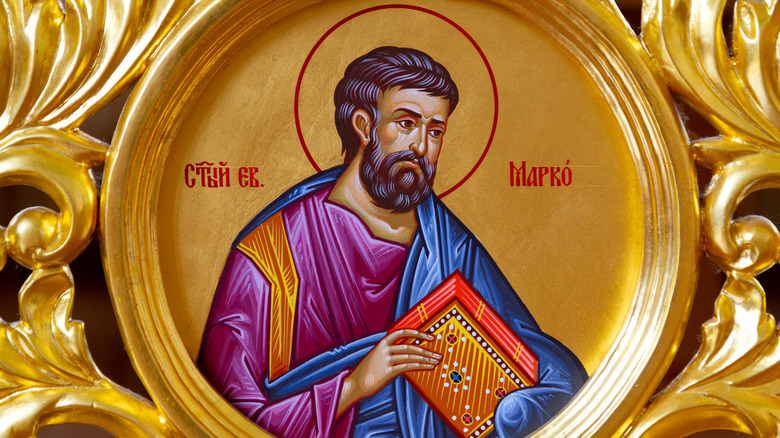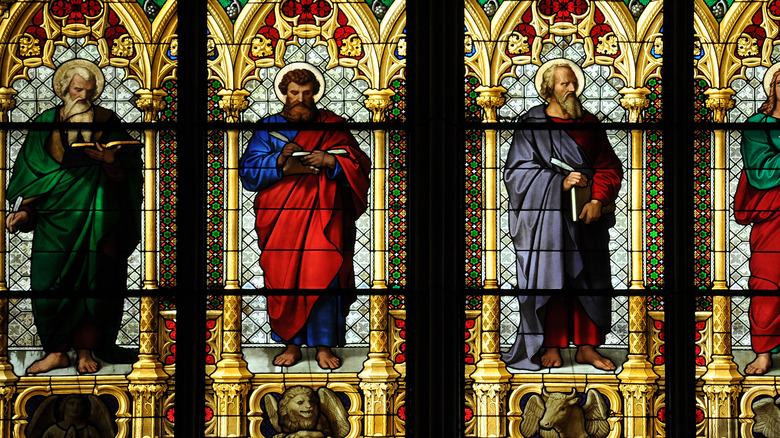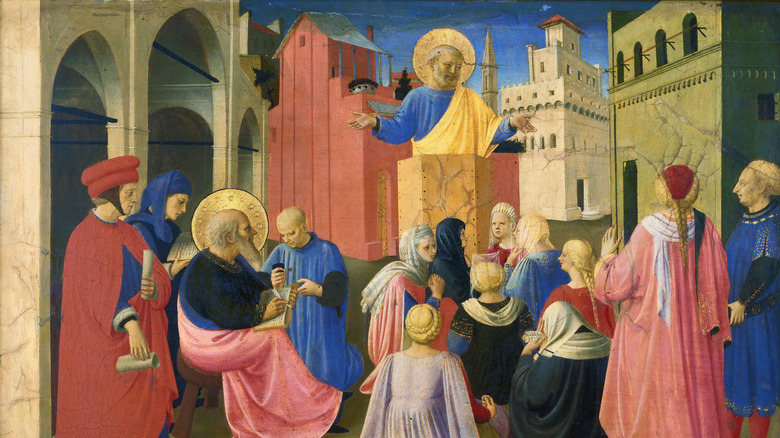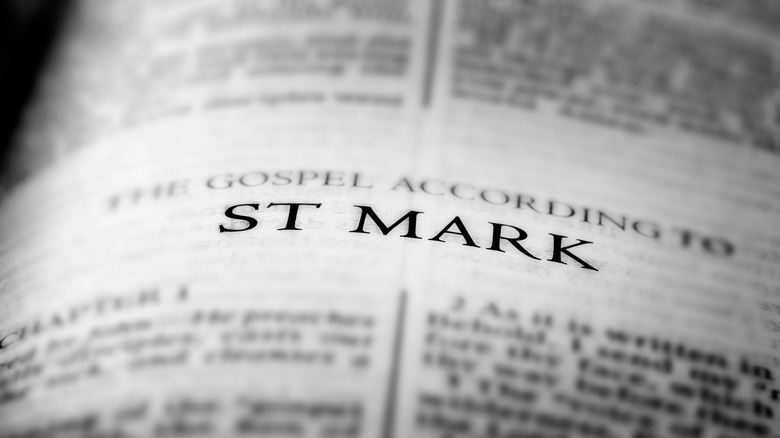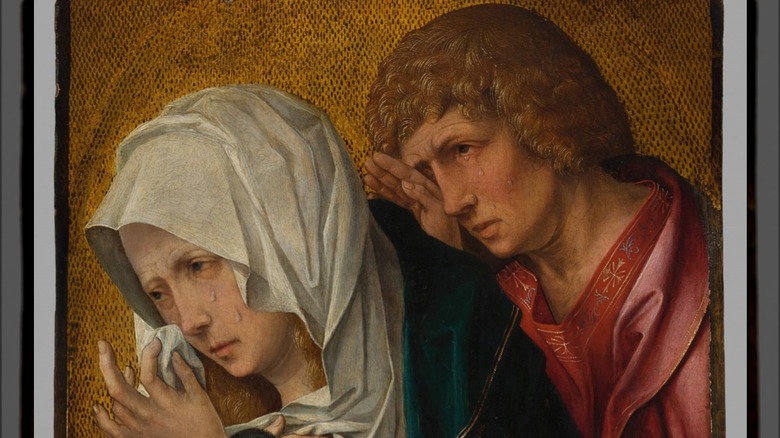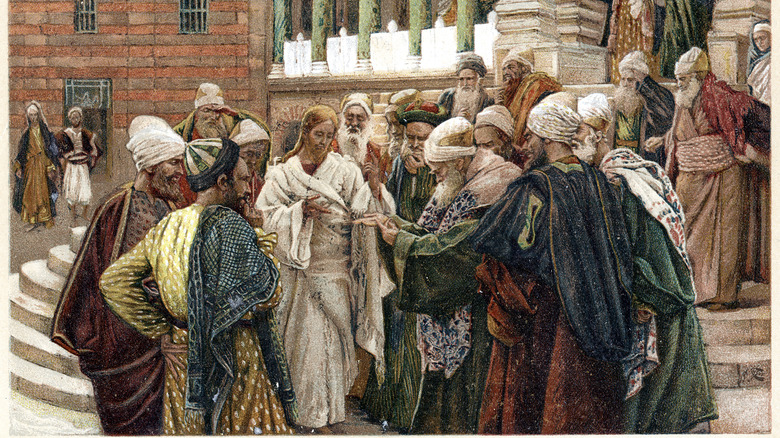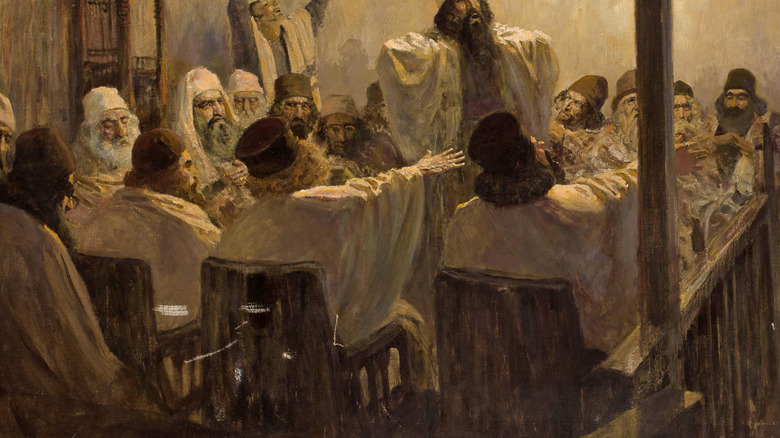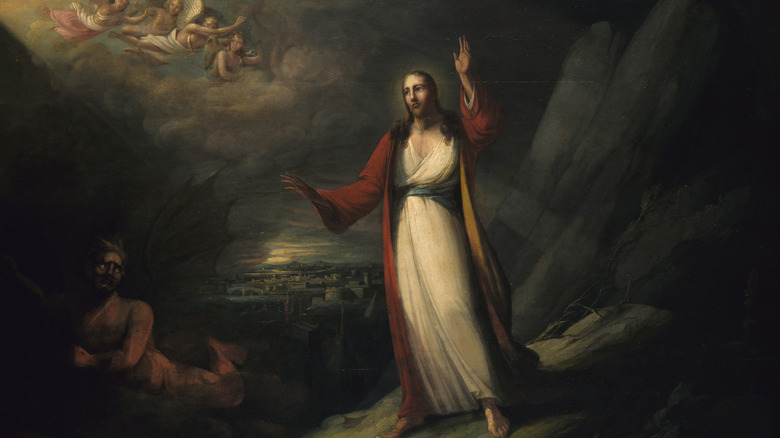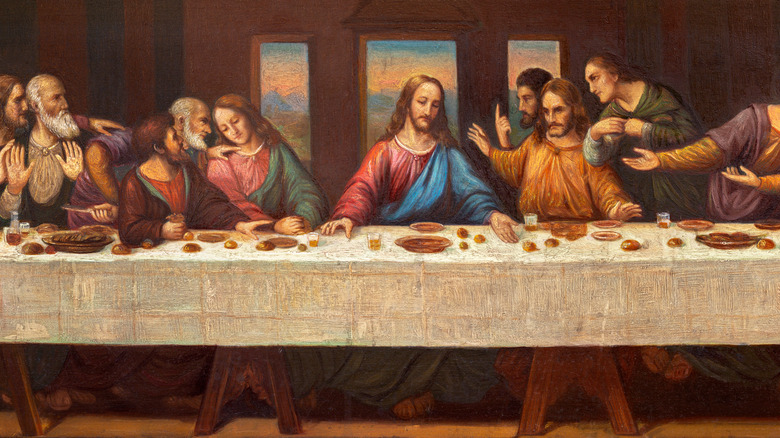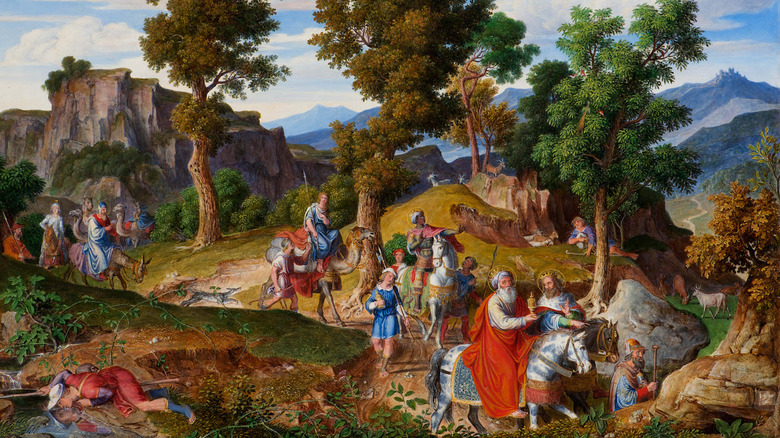The Biggest Differences Between The Gospels
The majority of information for the life of Jesus Christ comes from the Bible, which is often presented in one, single version for Christians to have a linear account of his ministry. However, the sources for Jesus' life are not nearly as neat as one would like.
The gospels, the four accounts that tell the story of Jesus' ministry, have many differences among them. Some, such as the differences between the synoptic gospels (Matthew, Mark, and Luke, per Britannica) and the Gospel of John are more obvious. As Britannica notes, the first three gospels have the same general collection of stories, while John includes a completely different set of stories.
Although John stands out from the rest, the synoptic gospels contain subtle differences between them that are meant to reshape the narrative to the benefit of the evangelist's audience. Sometimes, they may even reflect personal prejudices. Here are the biggest differences between the gospels and why they might have developed.
Mark doesn't seem too fond of doctors
The three main gospels, as noted in the National Catholic Register, are known as the "synoptic gospels," meaning they all view Jesus' life through the same lens, citing the same stories and accounts of his life with relatively few significant differences. That said, there are small but interesting differences that reflect how the authors viewed the society of 1st century AD Judea.
A small but interesting (and perhaps amusing) difference in the gospels is the difference with which Mark and Luke view doctors. When Jesus goes to heal the woman who had been suffering from hemorrhages, the two evangelists have very different words for the doctors. Luke, who as the NCR notes was a doctor himself, says in 8:43 that no one had been able to cure her. This is a fairly neutral take and unremarkable until one reads the other two evangelists' takes.
Mark, as the NCR notes, appears to take a much more critical approach. So while Luke doesn't even mention the doctors, simply saying that no one could cure her, Mark 5:26 says that the woman had suffered immensely under the physicians' treatment. Not only had their treatments made her suffer, they had taken all her money. Although not a huge difference, this contrast in narratives suggests that the writer of the Gospel of Mark viewed physicians, for lack of a better word, as "quacks."
Luke and Matthew are divided by religion, culture, and geography
A major difference between the synoptic gospels is that of audience. Mark, Luke, and Matthew, as Christianity.com notes, had different backgrounds, and their audiences were interested in Jesus for different reasons –- in part due to ethno-religious differences.
Beginning with Luke and Matthew, the two men could not have been from more different worlds. Luke was a Greek -– in other words a gentile -– physician, while Matthew was a Jew. Thus, they wrote in ways that were going to appeal to Greek and Jewish audiences, respectively.
According to the Blue Letter Bible Project, Luke's Hellenic heritage and mindset shows in his gospel, which is highly intellectual, filled with stirring speeches and songs reminiscent of the Greek poets and philosophers. He stresses Jesus' humanity, although he does not neglect his divinity either. Matthew, on the other hand, was a Jew who would have been interested in Jesus as the fulfillment of the prophecies of the Old Testament.
Matthew's Gospel was aimed at his fellow Jews, basically to make the case among them that Jesus was Israel's promised messiah. Thus, the focus is on portraying Jesus as the king of the Jews and the prophesized descendant of King David, who would come out of Bethlehem to deliver the world from its sins. For this reason, he even charts the descent of Jesus all the way from King David.
The Gospel of Mark: Short, sweet, and to the point
The Gospel of Mark deserves its own treatment because unlike the other two Synoptica, it is not aimed at any one group of people. In fact, as Blue Letter Bible notes, the gospel is by far the simplest of the four, containing the bare bones of Jesus' message for an audience completely alien to the Middle East.
The Gospel of Mark lacks the many speeches and intellectual/religious references found in Matthew and Luke. As Christianity.com notes, it is a very results-oriented gospel whose objective is to tell Jesus' story as simply as possible to those who are unfamiliar with Judea, Judaism, or the Hellenistic Eastern Mediterranean. Thus, the gospel begins not with the ancestry and birth of Jesus but with the beginning of Jesus' ministry.
Ultimately, Mark might be called the businessman's gospel given how to-the-point it is. But in the brevity and simplicity one can see the effectiveness given its context. Jesus' role as the fulfillment of Jewish prophecies or highly intellectual discourse based on Greek antecedents would have mattered little to the common man living in Roman Empire. Thus, what better way to convince this demographic of Jesus' message than by simply showcasing all his miracles among everyday people that an audience could identify with?
The Gospel of Mark is relatively lacking in detail
Mark's Gospel is a bit unique from the other Synoptica because it is much shorter (only 16 chapters) and lacks a number of key details. But as James Tabor, retired professor from the Department of Religious Studies at the University of North Carolina at Charlotte, writes on his blog, the missing details are quite significant. There is no mention of the Nativity, Jesus' virgin birth, Joseph the husband of Mary, or most concerning for early Christians, any appearance of the resurrected Christ.
Because the gospel was so short, early Christians worried that it was incomplete, particularly because it omitted any mention of Christ after the resurrection. Thus, it has been hypothesized that verses after 16:8, which describe Jesus' meeting with Mary Magdalene and the disciples after his resurrection, were added later to make the text more complete. However, the status of these verses is still disputed.
Among Catholics and Protestants, there are different ways of approaching the issue of Mark. The Catholic position, per the United States Conference of Catholic Bishops, is that the Gospel of Mark ends too abruptly, suggesting that the original ending may have been lost. Thus, verses 16:9-20 were likely added in later by someone, who, based on the style and vocabulary of the Greek, was definitely not the same person as the writer of the rest of the text. Nevertheless, the Catholic Church accepts the "longer ending" as canonical.
Among Protestants, there is less agreement because of the number of denominations, but Paul Carter of the Evangelical Gospel Coalition argues that while the verses after 16:8 should not be discarded -– since they still provide useful information — they should not be treated as inspired scripture.
The Nativity according to Mary and Joseph
Matthew and Luke, unlike Mark, both include Nativity accounts, which together form the classic Nativity narrative seen in scenes at Christmastime. But the accounts differ. Among the most salient differences between Matthew and Luke is each evangelist's focus on one of Jesus' earthly parents -– Mary and Joseph. Matthew's Nativity is mostly told from Joseph's point of view, whereas Luke's is from Mary's perspective.
So why this divergence? According to Christian Today, Matthew emphasizes Jesus' descent from King David (Bethlehem's other famous native) through Joseph. Jesus' Davidic pedigree serves as evidence for the fulfillment of the Old Testament prophecy that the ruler of Israel would come out of this small town. For Matthew's Jewish audience seeking evidence for Jesus' messiahship, this connection between Jesus and David through Joseph was crucial.
For Luke's audience, the main point is to show Jesus' difference with John the Baptist, who also has an infancy story in Luke's Gospel. As the USCCB states, the presentation of these two parallels is to highlight Jesus as the son of the Lord over John as the prophet of the Lord.
There is, however, another interesting take on Mary's role. As the University of Dayton notes, Mary was Jesus' first follower. She faithfully agreed to carry mankind's salvation, highlighting her crucial role in bringing God's light to the gentiles (like Luke). Thanks to this gospel, Mary is known as the "Mother of the Church."
John's is reportedly the only eyewitness account
The major differences in the gospels concern that of John versus the other three. The differences are legion, but they can be chalked down to one major detail that is often overlooked among lay Christians.
As John 13:23 and several other verses state, there is an unnamed disciple who is constantly referred to as the "one whom Jesus loved." As the National Catholic Register notes, the gospel later names this disciple as the writer of the gospel. Generally, this has been interpreted as the Apostle John, son of Zebedee one of Jesus' first two disciples. More importantly however, this apostle would have known Jesus personally. And this crucial detail helps explain why the Gospel of John is so different.
As noted in the Blue Letter Bible Project, the synoptic gospels, while all attempting to convince audiences of Jesus' divinity, also focus on Jesus' earthly role as king of the Jews, the perfect man, and servant. But John's primary emphasis is on Jesus the Son of God. This makes sense. According to Catholic Answers, John witnessed the death of Jesus at the foot of the cross and met him after he had risen from the dead. Jesus entrusted his mother Mary to him, giving the apostle an intimate window into Jesus' life and divinity that the others -– as second-hand writers -– could not have had. This shows in his gospel, which is considerably more detailed than the other three, giving a picture of Jesus in all his glory as God incarnate.
John explicitly equates Jesus to God
John's gospel contains a series of Jesus' statements, which all contain the phrase "I am." There are a few instances where is stands out because it does not grammatically make sense. John 8:58 is a perfect example, wherein John writes that Jesus said "before Abraham came to be, I am" instead of the grammatically correct and expected "I was."
Yet these statements are no typos. According to Biola University, they only appear in the Gospel of John and are Jesus' declaring himself (in at least some cases) to be God on Earth. As the university explains, in saying "I am," Jesus is identifying himself the same way as God's identified himself to Moses in Exodus 3:4 — with the then-mysterious name "I am who I am."
These declarations are by far Jesus' most explicit claims to godhood and land him in serious trouble with the Jewish religious authorities in the Temple, who attempt to stone him for blasphemy. These bold declarations contrast with the synoptic gospels, whose claims to godhood are a bit more muted. For instance, Matthew 11:27 mentions "my Father," presumably referring to God, as does Luke 22:29. The difference in language might be explained by the fact that John heard Jesus equate himself to the God of Israel firsthand and used those references to strengthen Jesus' position as the messiah and build a case against the Jewish religious authorities who would later expel Jesus' followers from the faith.
John's curious case of the Jews: Anti-Judaism or infighting?
According to "Jews and Christians: Exploring the Past, Present, and Future," the Gospel of John is unique among the gospels for its hostility towards a group simply labeled as "the Jews." On the surface, this would appear an expression of anti-Judaism, or in modern times, anti-Semitism. As the book notes, this usage has led to considerable polemic between Jews and Christians and accusations of anti-Semitism over the meaning of this phrase and the sentiment behind it — something virtually absent from the Synoptica.
In the Synoptica, the term "Jew" mostly appears in reference to Jesus' title as "King of the Jews." It serves little purpose as an insult because Jesus, his opponents, and his disciples are all Jewish. The Gospel of John is no different in that regard. Thus, the phrase "the Jews" cannot refer to all Jews (unless John was targeting himself and Jesus) and cannot carry the anti-Jewish meaning ascribed to it in modern polemic. Thus, it likely refers to the Jewish religious authorities, specifically those who denied Jesus' messiahship and clashed with his followers.
The Gospel of John was written at a time when Judaism was split between the followers of Jesus and the Pharisees. Eventually, the Jewish authorities expelled Jesus' followers from the synagogues, and they became a new religion known today as Christianity. John's polemic against "the Jews" likely refers to bitterness over this dispute, since the followers of Jesus never considered themselves anything but Jews.
The synoptic demons vs. John's Satan
Among the major themes of the Synoptica is Jesus casting out demons and healing their victims. Among the best known is Matthew 8:28, in which Jesus drives a legion of demons into a herd of pigs, who then plummet into the sea and drown. While this narrative and others are present in Mark and Luke too, Jesus, expeller of demons, is completely absent from the Gospel of John.
So why the difference? According to the journal Neotestamentica, the reason for this glaring omission is once again a matter of perspective. John had bigger ambitions than simply painting Jesus as a healer and exorcist. He wanted to paint Jesus as the conqueror of the world's ultimate evil –- Satan himself.
Thus, instead of giving the accounts of Jesus casting out demons, John focuses on the ultimate exorcism -– the crucifixion. According to Neotestamentica, when Jesus died on the cross, he freed the world of its sin, triumphing over Satan (aka "the prince of this world"). This, along with the resurrection, was the most important event in salvation history. Since John's gospel wanted to leave few doubts as to Jesus' divinity and messiahship, his ultimate triumph over the demon of demons was much more important than exorcisms over lesser demons.
The Last Supper vs. the washing of the feet
The story of the Last Supper is well known and generally the same across all four of the gospels. Jesus and his disciples meet in a room and share a final meal together before he is eventually arrested, tried, and crucified, as per Britannica. But although the timelines are generally similar, there are a few crucial differences in the narrative.
First up is the timing. Mark 14:12 and the other Synoptica, as noted by Pope Benedict XVI (via the Catholic Education Resource Center), all describe the Last Supper as a Passover meal. John 13:1, however, seems to contradict this argument, claiming the meal occurred before Passover. Scholars, as the pontiff notes, have discussed this seeming contradiction, which has yet to be explained with certainty.
The other key difference is the role of the Eucharist and foot-washing at the meal. In the synoptica (e.g. Mark 14:22), Jesus tells his disciples to eat his body and drink his blood. As noted on Catholic Resources, John omits this from his gospel and instead focuses on Jesus' exhortation for his disciples to wash the feet of others as he has washed theirs (John 13:14). Catholic Insight suggests that John omitted the Eucharist at the Last Supper because he had already touched on it in the story of Jesus multiplying the bread and fish.
The question of the Magi (aka the Three Kings)
Among the most famous stories, captured in carols and holidays around the world, is the visit of the Three Wise Men (aka "the Three Kings") to the baby Jesus after his birth in Bethlehem. Given how widespread this tale is, one would expect to find it in all four gospels. Yet it only appears in Matthew.
Matthew 2:1 calls these wise men "Magi," which, according to the Encyclopedia Iranica, were Iranian Zoroastrian priests skilled in the arts of astrology and fortune-telling. They traveled from "the East" (presumably the Iranian world) to adore Jesus as their king. However, details are sparse, as Matthew only dedicates 12 verses to it. Thus, one must extrapolate its literary function from Matthew's overall goal in the gospel.
Although the explanation for the story's inclusion is far from certain, it seems to relate to Old Testament prophecies. Matthew's case for Jesus as a specifically Jewish messiah depicted Christ as the fulfillment of Old Testament biblical prophecies, which would have been familiar to his audience, as per the Blue Letter Bible Project. Among these is Psalm 72:10, which foretells a king who would receive adoration and wealth from the rulers of distant lands.
As New Advent notes, Christians considered the Magi's coming as the fulfillment of Psalm 72 (albeit not literally). Three distinguished, wise men bearing rich gifts traveled from faraway lands to adore this new king of Jews and gentiles alike. If Jesus fulfilled this old Jewish prophecy, it was yet another piece of evidence in his favor (from Matthew's perspective) that he was indeed Israel's promised savior.
